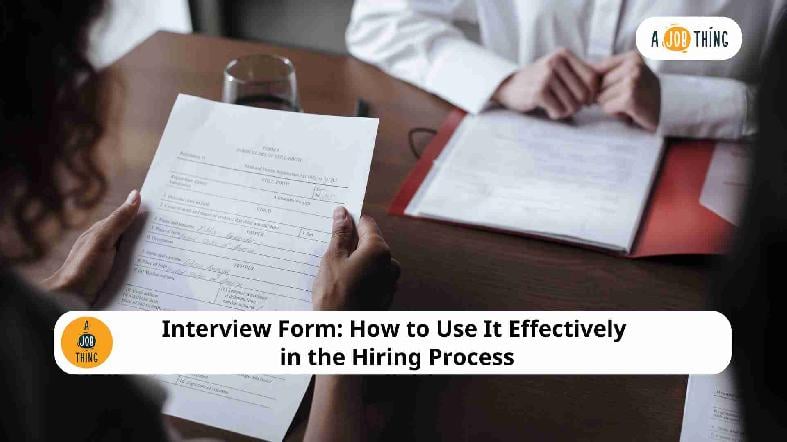
Interview Form: How to Use It Effectively in the Hiring Process
Are You Hiring?
Find candidates in 72 Hours with 5+ million talents in Maukerja Malaysia & Ricebowl using Job Ads.
Hire NowHave you ever done interviews and decided on the chosen candidate by relying on memory and gut feelings? Be careful. This can lead to inconsistent hiring decisions.
To avoid this, you can use an interview form. It can give structure to your process, helping you capture each candidate’s strengths, spot gaps, and make more confident hiring choices.
What is an Interview Form?
An interview form is a document used during the hiring process to collect and record information about a job candidate. It helps interviewers stay organised and evaluate each candidate based on the same criteria.
Each interviewer may have their own copy of the form, especially in group interviews or multi-stage processes.
These forms create a record that can be reviewed later when deciding which candidate is the best fit for the role. They also provide a clear structure to guide the conversation.
Using interview forms in hiring improves fairness, reduces bias, and gives interviewers a shared reference when discussing candidates.
Why are Interview Forms Important?
A structured interview form helps employers stay consistent, especially when dealing with multiple candidates for the same role. It also helps when there is more than one interviewer involved. Everyone will be referring to the same set of evaluation points.
Instead of relying on memory or personal impressions, interviewers can refer to their notes and compare candidates objectively. This helps reduce hiring mistakes and supports better documentation if hiring decisions are ever questioned.
Types of Interview Forms and Their Purposes
There are different types of interview forms, and each one supports a specific part of the hiring process. You don’t need to use all of them at once, but it helps to understand what they are and when to use them.
Pre-screening Interview Form
Usually used at the early stage to check basic details, such as candidate availability, working hours preference, and interest in the company.
Telephone Interview Form
When conducting phone interviews, interviewers can asses basic communication skills, confirm job expectations, and gather first impressions by using the form.
In-Person or Face-to-Face Interview Form
It helps the interviewer assess things like attitude, presentation, knowledge, and fit for the company. Because of these, the form is more detailed.
Panel Interview Form
This form is to be used when there are multiple interviewers in the same session. Each panelist may fill out the same form independently, and then the group discusses the responses later.
Technical Interview Form
It emphasizes skills that are specific to a job. This type is commonly utilized for positions that demand particular technical expertise, such as in IT, engineering, or accounting.
Behavioural Interview Form
It helps interviewers evaluate how candidates handle past situations.
Questions like "Tell me about a time you handled a difficult customer" are scored based on how well the candidate’s answer shows problem-solving, leadership, or communication skills.
Final Interview Summary Form
In this form, the HR compiles everything at the end of the hiring process. It gives a summary of the candidate’s strengths, weaknesses, and final recommendation.
Interview Forms Examples Based on Type (DOC, PDF)
Pre-screening Interview Form
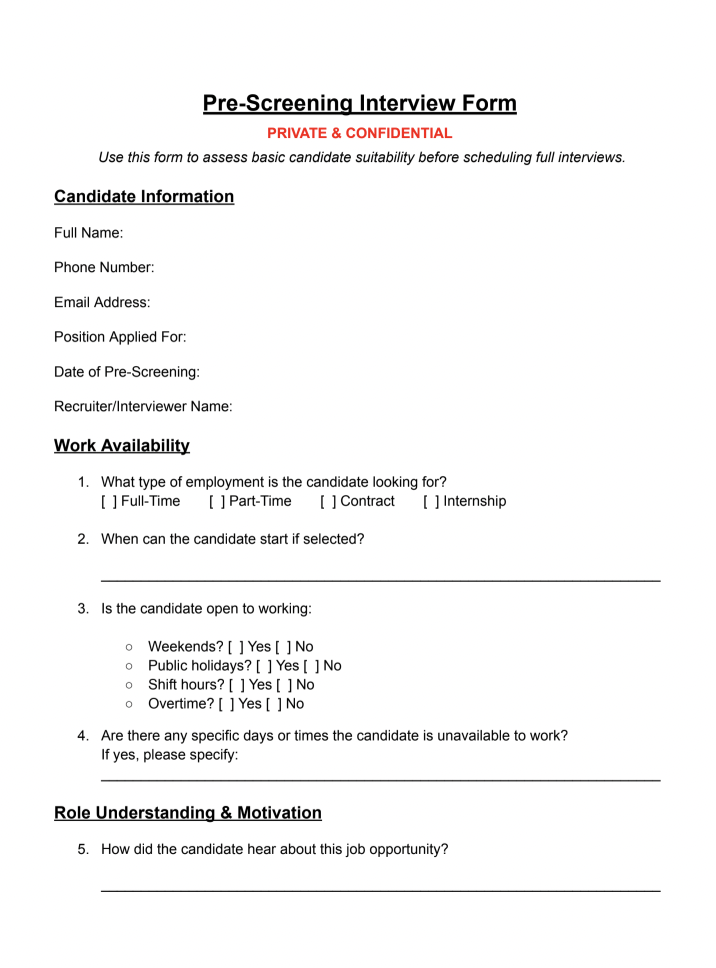
Telephone Interview Form

In-Person or Face-to-Face Interview Form
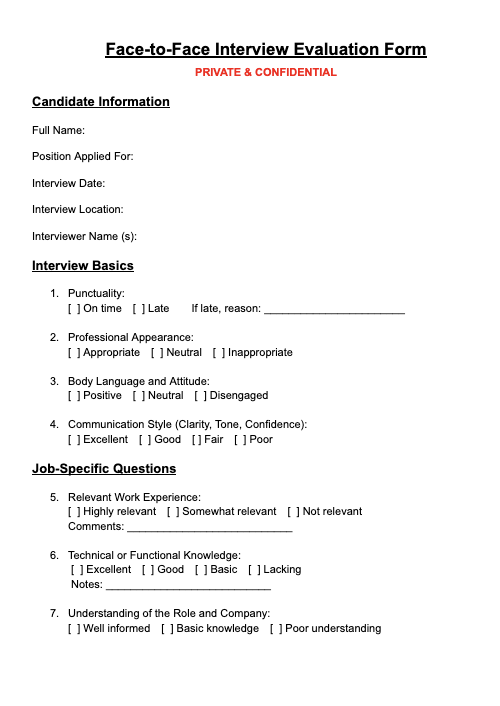
Panel Interview Form

Technical Interview Form
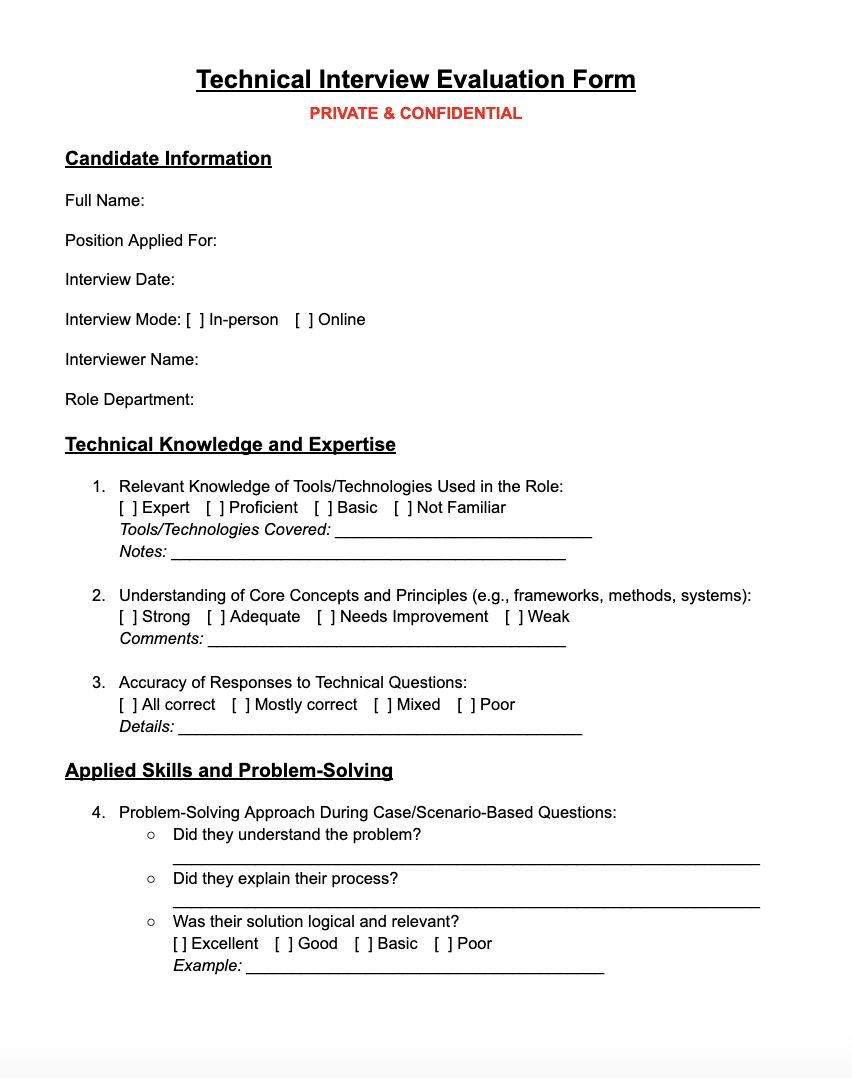
Behavioural Interview Form

Final Interview Summary Form
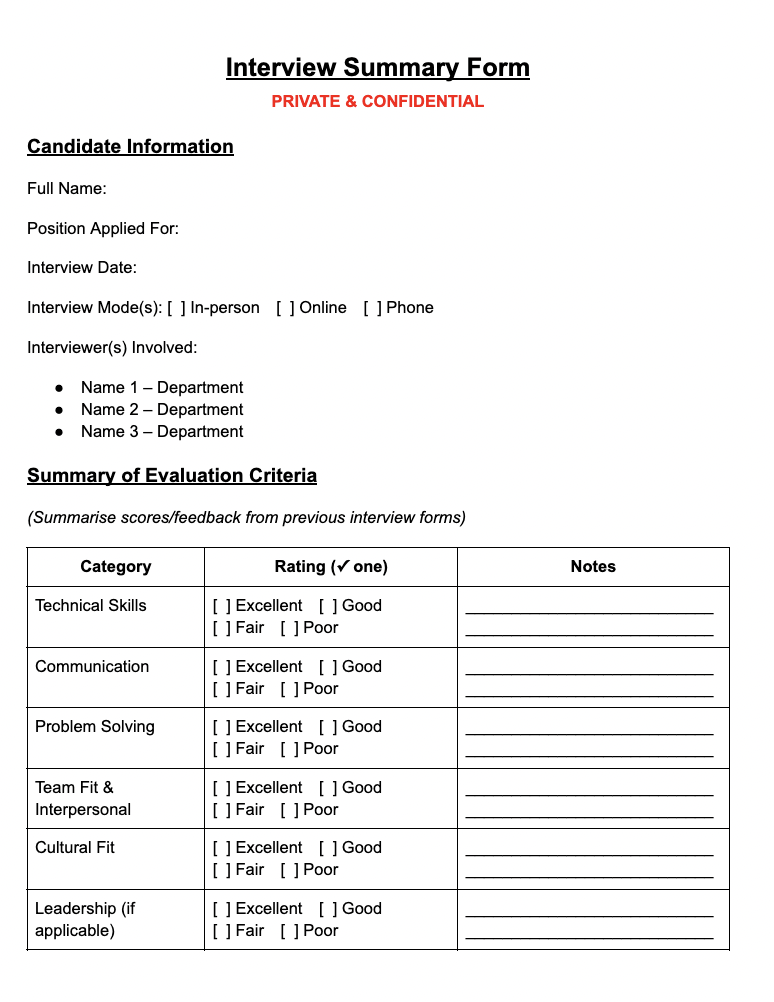
Tips to Prepare for Interviews
Here are some useful tips to help employers prepare for interviews and get the most out of their interview forms:
Match forms with job descriptions
Make sure the questions and evaluation sections in the form are relevant to the role.
For example, a sales position should focus on communication and persuasion skills, while a technical role might prioritise coding or system knowledge.
Use consistent questions across candidates
Standardising questions makes it easier to compare candidates fairly. This also helps reduce bias and keeps interviews aligned with hiring goals.
Add rating scales
Incorporate a clear scoring system, like 1 to 5, for key criteria. With this, interviewers make quick comparisons later and keep the process structured.
Prepare interviewers beforehand
Spend a few minutes before each session to review the form and clarify how to use it.
Make sure all interviewers understand what to look for and how to record feedback properly.
Leave space for open comments
Sometimes numbers don’t tell the full story. Leave a section for additional notes so interviewers can record impressions or specific responses.
Review forms together after the interview
After interviewing all candidates, bring the completed forms together for discussion. Reviews and balance perspectives, highlight strengths and concerns, and support final decisions.
FAQ
Can I reuse the same interview form for different roles?
It’s better to customise forms based on job roles. While some sections can be the same, each role has different requirements. A technical role and a sales role won’t need the same evaluation focus.
How do I store completed interview forms?
Forms can be saved as physical files or stored digitally in your HR system. If you’re using Google Forms or Microsoft Forms, responses can go directly into a spreadsheet for easy review.
Is it mandatory to use interview forms in Malaysia?
No, there is no legal requirement. But using interview forms is a good HR practice that helps you stay organised and objective.
Can interview forms help protect against unfair hiring claims?
Yes. If hiring decisions are challenged, documented interview forms show that you used consistent and job-related criteria.
Should I digitise my forms using Google Forms or HR software?
Yes, if possible. Digital forms are easier to track, share, and store. They also save time when collecting feedback from multiple interviewers.
Looking to Hire the Best Candidates?
Let AJobThing help you find the right people who will grow with your company.
Post your job ads and connect with top talent across platforms like Maukerja, Ricebowl, and Epicareer today.
Read More:
- What to Include in an Exit Interview Form (With Template & Example)
- Full LHDN Stamp Duty Guide on Malaysia Employment Contract [2025]: Penalties, Exemptions, & More
- How Employers Can Embrace National Work From Home Day in 2025
- How to Handle Employees Who Abscond from Work in Malaysia
- Dependant Pass Malaysia 2025: Eligibility, Process, and HR Tips
- Who Can Look at Employee Personnel Files?
- Why a Clear Signing Off From Work Policy Matters
- What is Work Life Balance? Benefits, Factors, and How to
- 75 Company Gift Ideas for Employee Resignation
- 150+ Nama Nama Company Yang Best to Inspire Your Business Name
- Jadual Caruman KWSP 2024/2025 (EPF Contribution Schedule)
- EPF Voluntary Contribution in Malaysia: How It Works & Benefits
- STR 2025 (Sumbangan Tunai Rahmah): Eligibility, Payment Dates & How to Apply
- CP22 Form: Deadline, Free Download Form, How to Fill
- CP204: Deadline, Calculation, & Free Download Form
- How to Use ByrHASiL for Online Tax Payments in Malaysia
- PCB Deduction in Malaysia: Calculation, Rates & Employer Guide
- What is the 182 Days Rule in Malaysia? Tax Residency Explained
- Labour Law Malaysia Salary Payment For Employers
- Best Answers for 'Why Should We Hire You' – A Guide for Employers
- 12 Employment Types You Need to Know: A Guide for Employers
- What is Precarious Employment? Risks, Challenges, and Solution
- New EPF Retirement Savings: Helping Employers Support Financial Well-Being for Employees
- Higher Pensioners in 2024, Government Set to Finalize Pension Rates
- Lack of Diversity in Candidate Pool: Why It Matters and How to Improve It

